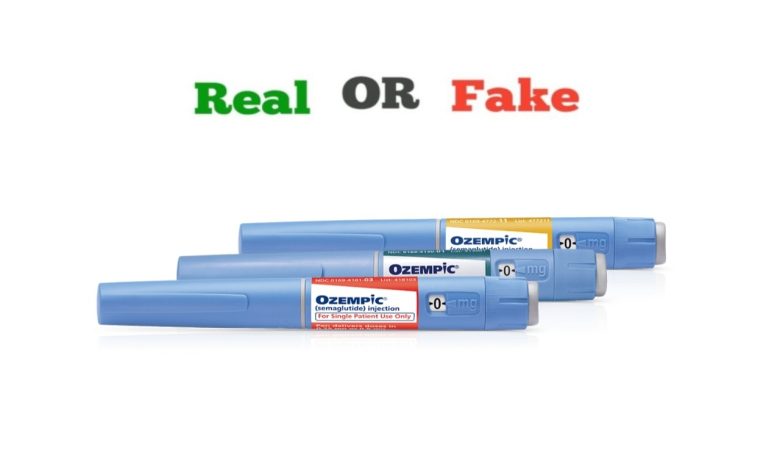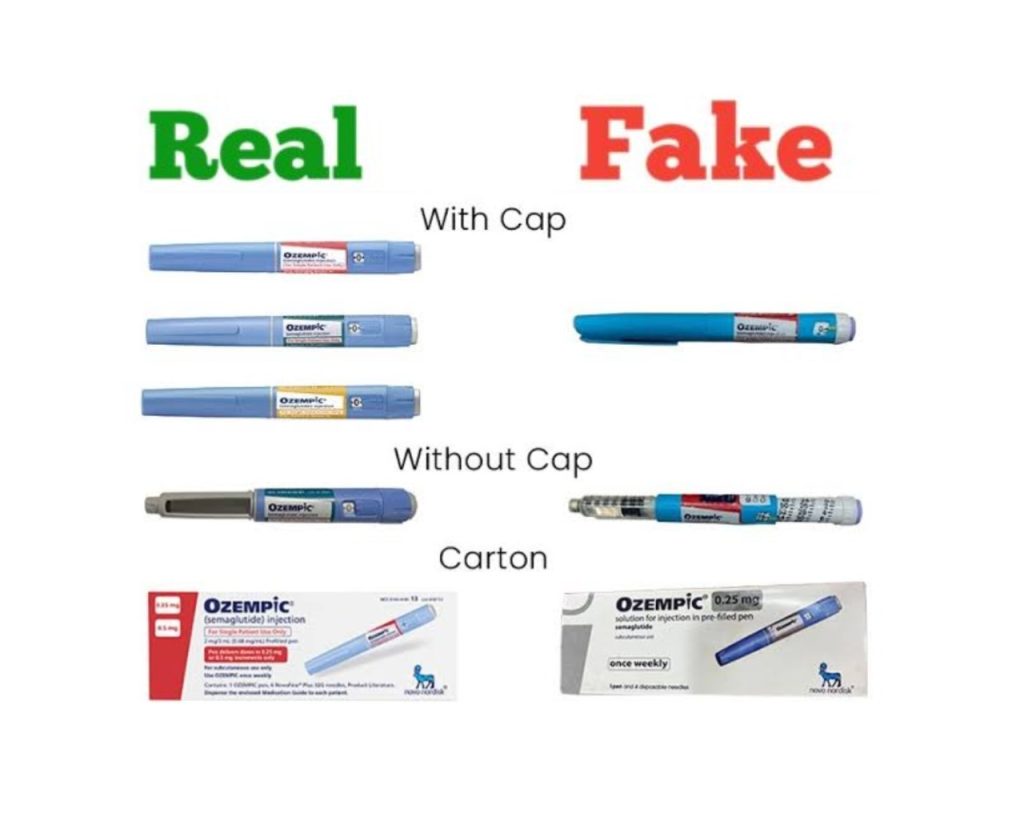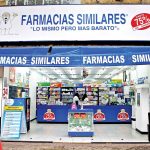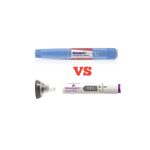How to Spot Fake Ozempic Pens

CBS News recently reported that the Food and Drug Administration (FDA) is investigating reports of hospitalizations related to suspected counterfeit semaglutide drugs, which include the popular diabetes medication Ozempic. This alarming development has raised concerns about the safety and authenticity of prescription medications in the market.
At least three Americans have been hospitalized after using suspected counterfeit semaglutide drugs, and there have been 42 reports globally with 28 classified as “serious,” including some deaths. To protect your health and well-being, it is essential to understand how to spot fake Ozempic pens and other counterfeit medications.
What you should know
Ozempic and Wegovy, both semaglutide medications manufactured by Novo Nordisk, have been experiencing a shortage for months due to their increased use in weight loss and the treatment of type 2 diabetes. This high demand has created an opportunity for counterfeiters to exploit the situation, leading to potentially life-threatening consequences for unsuspecting individuals.
Reports of hospitalizations related to counterfeit semaglutide have raised significant concerns in the medical community and among regulatory agencies, leading to investigations by the FDA and its counterparts worldwide. While the reports do not definitively prove a direct link between counterfeit drugs and hospitalizations, they underscore the importance of being vigilant when it comes to purchasing and using prescription medications.
What Counts as a Counterfeit Ozempic?
Counterfeit medications can take various forms, and it’s essential to be aware of potential signs that may help you identify them. One alarming case involved a counterfeit Ozempic pen that was sold by a retail pharmacy in the United States. The counterfeit pen had a fake label and carton that closely resembled the authentic Novo Nordisk packaging.
However, there were telltale differences that could have tipped off patients that they had purchased a counterfeit product. In response to these incidents, Novo Nordisk has been working closely with the FDA to create awareness and provide guidance on identifying counterfeit products. They have posted a guide on their corporate website to help consumers differentiate between genuine and fake Ozempic pens.
It’s important to understand that counterfeit medications may not always be easy to spot, and there could be variations in the methods used by counterfeiters. Patients must remain vigilant and take the necessary precautions when purchasing prescription medications.
Counterfeit Reports and Concerns
The recent surge in counterfeit semaglutide medications, including Ozempic, has prompted regulatory agencies like the FDA to take action and warn the public. These reports are a cause for concern for several reasons:
1. Hospitalizations and Deaths: The hospitalizations and, in some cases, deaths reported in connection with suspected counterfeit semaglutide highlight the severe risks associated with counterfeit medications. Individuals relying on these medications for the management of their health conditions may unknowingly put their health and lives in jeopardy.
2. Potentially Fake Ozempic Pens: The Medicines and Health Products Regulatory Agency in the UK reported seizing hundreds of “potentially fake Ozempic pens” since January 2023. This underscores the global nature of the problem, with counterfeit products making their way into various markets.
3. Investigations and Schemes: The FDA and other regulatory agencies are actively investigating schemes related to counterfeit pens being trafficked into pharmacies. This situation not only endangers patients but also undermines trust in the healthcare system.
Semaglutide Alternatives: A Compounding Concern
While the focus has primarily been on counterfeit semaglutide medications, there is also concern about semaglutide alternatives. Some of these alternatives are manufactured by drug compounders, such as pharmacies. During the shortage of Ozempic and Wegovy, compounders are allowed to sell unapproved semaglutide to Americans. However, these products are not subject to the same level of FDA oversight and quality control as genuine medications.
The FDA has received an increasing number of adverse event reports and complaints related to compounded semaglutide products. This raises questions about the safety and effectiveness of these alternatives, as well as the need for enhanced oversight and regulation in this sector.

How to Spot Fake Ozempic
To protect your health and ensure the authenticity of your prescription medications, it’s crucial to know how to spot fake Ozempic pens and other counterfeit drugs. Here are some essential steps and tips:
1. Purchase from Reputable Sources: Obtain your Ozempic or other prescription medications from trusted and licensed sources, such as your healthcare provider, a well-established pharmacy, or a reputable online pharmacy with a physical address and proper certifications. Be cautious of websites offering deep discounts or unrealistic deals.
2. Inspect the Packaging: Examine the packaging for signs of tampering, damage, or irregularities. Authentic Ozempic pens should come in sealed and unbroken packaging. Be suspicious of any packaging that appears to have been opened or resealed.
3. Verify the Label and Information: Carefully scrutinize the label on the pen to ensure it matches the official Ozempic branding. Pay attention to the font, colors, logo, and overall appearance. Look for misspellings or irregularities on the label.
4. Check the Expiration Date: Confirm that the expiration date on the packaging is not past or too close to the current date. Counterfeit medications may have incorrect or expired dates. If the date seems suspicious, contact your healthcare provider or pharmacist for guidance.
5. Authenticate the Lot Number and Serial Number: Each Ozempic pen has a unique lot number and serial number. You can contact Novo Nordisk (call 1-800-727-6500) or a healthcare provider to verify if these numbers are legitimate and correspond to the medication you received. Be wary of any inconsistencies in the numbers.
6. Inspect the Pen Itself: Carefully examine the appearance of the Ozempic pen. Ensure it is in pristine condition, and the product inside should be clear and free from any particulate matter or unusual substances. Any signs of tampering or irregularities with the pen should raise concerns.
7. Consult with Healthcare Professionals: If you have any doubts or concerns about the authenticity of your Ozempic pen, do not hesitate to consult with your healthcare provider or pharmacist. They can provide guidance on verifying the legitimacy of the medication and offer advice on its proper usage.
8. Report Suspicious Products: If you suspect that you have received a counterfeit Ozempic pen or encountered any counterfeit medication, report it to the relevant authorities. In the United States, this would be the FDA. Reporting such incidents is crucial for protecting public health and preventing harm to others.
9. Be Cautious of Online Purchases: If you choose to purchase medication online, exercise extreme caution. Ensure the website is reputable and follows all legal and safety regulations. Avoid websites that do not require a prescription, have suspicious payment methods, or offer medications at significantly discounted prices.
What to do if you have a fake Ozempic in your possession
If you suspect that you have a fake Ozempic pen in your possession, it is crucial to take immediate steps to protect your health and ensure that you do not use counterfeit medication. Here’s what to do if you believe you have a fake Ozempic pen:
1. Stop Using the Medication: Do not use the suspected counterfeit Ozempic pen. Using counterfeit medication can be dangerous, ineffective, and potentially harmful to your health.
2. Isolate the Medication: Keep the suspected fake Ozempic pen separate from your other medications to avoid any confusion or accidental use.
3. Contact Your Healthcare Provider: Reach out to your healthcare provider as soon as possible. They can offer guidance, assess your health, and provide alternatives if necessary. It’s important to discuss the situation with a medical professional who is familiar with your medical history and condition.
4. Report the Incident: Contact the appropriate regulatory authorities to report the counterfeit medication. In the United States, you should report the incident to the Food and Drug Administration (FDA). Reporting helps protect others from potential harm and allows authorities to track and investigate the source of counterfeit medications.
5. Provide Details: When reporting the incident, be prepared to provide as much information as possible about the suspected counterfeit Ozempic pen, including where and when you obtained it, the lot number, serial number, packaging details, and any other relevant information.
6. Cooperate with Authorities: If necessary, cooperate with any investigations conducted by the FDA or other relevant regulatory agencies. Your information may be vital in identifying the source of counterfeit medications and preventing further distribution.
7. Dispose of the Medication Safely: If directed by your healthcare provider or regulatory authorities, safely dispose of the suspected counterfeit medication to prevent it from accidentally entering the legitimate supply chain. Do not flush it down the toilet or throw it in the trash. Instead, inquire about safe disposal methods in your area.
8. Replace the Medication: Work with your healthcare provider to obtain a legitimate and safe replacement for your Ozempic prescription. They can guide you on how to obtain authentic medication and adjust your treatment plan accordingly.
9. Be Cautious in the Future: Learn from the experience and be vigilant when obtaining prescription medications. Purchase your medications from reputable sources, such as licensed pharmacies and healthcare providers, to minimize the risk of receiving counterfeit products.
It’s important to remember that your health and safety should be your top priority. Suspected counterfeit medication poses a significant risk, and taking immediate action is essential to protect yourself and prevent others from encountering the same danger. By reporting the incident to regulatory authorities, you contribute to efforts to identify and address the sources of counterfeit medications, ultimately enhancing public safety.





